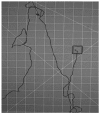Diffusion Rates and Dispersal Patterns of Unfed versus Recently Fed Bed Bugs (Cimex lectularius L.)
- PMID: 26466900
- PMCID: PMC4693170
- DOI: 10.3390/insects6040792
Diffusion Rates and Dispersal Patterns of Unfed versus Recently Fed Bed Bugs (Cimex lectularius L.)
Abstract
Bed bug problems have been increasing since the 1980s, and accordingly, there have been intensive efforts to better understand their biology and behavior for control purposes. Understanding bed bug diffusion rates and dispersal patterns from one site to another (or lack thereof) is a key component in prevention and control campaigns. This study analyzed diffusion rates and dispersal patterns in a population of bed bugs, recently fed and unfed, in both one-dimensional and two-dimensional settings. When placed in the middle of a 71 cm × 2.7 cm artificial lane, approximately half of the bugs regardless of feeding status stayed at or near the release point during the 10 min observation periods, while about a fourth of them walked to the end of the lane. When placed in the middle of an arena measuring 51 cm × 76 cm and allowed to walk in any direction, approximately one-fourth of bed bugs, fed or unfed, still remained near their release point (no significant difference between fed or unfed). As for long-distance dispersal, 11/50 (22%) of recently fed bed bugs moved as far as possible in the arena during the 10 min replications, while only 2/50 (4%) unfed bed bugs moved to the maximum distance. This difference was significantly different (p < 0.0038), and indicates that unfed bed bugs did not move as far as recently fed ones. A mathematical diffusion model was used to quantify bed bug movements and an estimated diffusion rate range of 0.00006 cm²/s to 0.416 cm²/s was determined, which is almost no movement to a predicted root mean squared distance of approximately 19 cm per 10 min. The results of this study suggest that bed bugs, upon initial introduction into a new area, would have a difficult time traversing long distances when left alone to randomly disperse.
Keywords: aggregation activity; bed bugs; host-seeking; locomotor activity.
Figures









Similar articles
-
Host Searching and Aggregation Activity of Recently Fed and Unfed Bed Bugs (Cimex lectularius L.).Insects. 2011 May 4;2(2):186-94. doi: 10.3390/insects2020186. Insects. 2011. PMID: 26467621 Free PMC article.
-
Mark-Release-Recapture Reveals Extensive Movement of Bed Bugs (Cimex lectularius L.) within and between Apartments.PLoS One. 2015 Sep 9;10(9):e0136462. doi: 10.1371/journal.pone.0136462. eCollection 2015. PLoS One. 2015. PMID: 26352145 Free PMC article.
-
Effect of Feeding History and Time Elapsed From Field Collection on the Movement Behavior and Response to Stimulation in Cimex lectularius (Hemiptera: Cimicidae).J Econ Entomol. 2017 Aug 1;110(4):1719-1727. doi: 10.1093/jee/tox148. J Econ Entomol. 2017. PMID: 28541568
-
Bed bugs (Cimex lectularius) and clinical consequences of their bites.JAMA. 2009 Apr 1;301(13):1358-66. doi: 10.1001/jama.2009.405. JAMA. 2009. PMID: 19336711 Review.
-
Stress Tolerance of Bed Bugs: A Review of Factors That Cause Trauma to Cimex lectularius and C. Hemipterus.Insects. 2011 Apr 29;2(2):151-72. doi: 10.3390/insects2020151. Insects. 2011. PMID: 26467619 Free PMC article. Review.
References
-
- Little S.E., West M.D. Home infestation with Cimex lectularius, the common bed bug, affecting both dog and client (Abstract No. 61); Proceedings of the American Association of Veterinary Parasitologists Annual Meeting; New Orleans, LA, USA. 19–22 July 2008.
-
- Ryckman R.E., Bently D.G., Archbold E.F. The Cimicidae of the Americas and oceanic islands, a checklist and bibliography. Bull. Soc. Vector Ecol. 1981;6:93–142.
-
- Potter M.F. The perfect storm: An extension view on bed bugs. Am. Entomol. 2006;52:102–104. doi: 10.1093/ae/52.2.102. - DOI
LinkOut - more resources
Full Text Sources
Other Literature Sources
Research Materials


